Spirogyras are common free-floating freshwater algae that inhabit ponds, pools, tanks, lakes, ditches, etc. The word ‘Spirogyra’ is derived from the two Greek words, ‘Speria’, meaning coil, and ‘gyras’ meaning twisted. Spirogyra has many common names, including blanket weed, water silk, mermaid`s tresses, etc. It grows up to several centimeters in length and 10-100 μm in width.
There are about 400 known species of Spirogyra worldwide. They are filamentous and slippery in natures due to the presence of external mucilaginous sheath; hence, they are called pond scum or pond silk. Some of the species of Spirogyra (Spirogyra adnata, S. jogensis) bear holdfast or haptera by which they remain attached to the substratum.
You might also read: Bryophyta: Characteristics and Classification
Systematic Position
Division:Chlorophyta
Class: Chlorophyceae
Order: Zygnematales
Family: Zygnemataceae
Genus:Spirogyra
Species:Spirogyra maxima, S. negnecta, S. elongate, S. adnata, S. nitida, etc.
Identifying Characteristics of Spirogyra
- They have a multi-cellular filamentous body with a mucilaginous sheath.
- They bear 2-10 spiral and ribbon-shaped chloroplasts with many pyrenoids.
- The cell wall is composed of pectin and cellulose.
- It reproduces vegetatively and sexually.
- Under lower temperature, vegetative reproduction occurs.
- It inhabits slow running water bodies and shows the mass of long shining silky filaments in running water; hence, it is known as pond silk.
Spirogyra is un-branched green algae that belong to the class Chlorophyceae under order Zygnematales. It consists of long identical cylindrical cells situated one above the other, without any differentiation into base and apex. It bears 2-10 spiral ribbon-shaped chloroplasts with many pyrenoids, which are the distinctive characteristic features of Spirogyra.
Their margins may be smooth or serrated. Spirogyra floats freely in masses over the surface of the water and is moved in favor of water current. But Spirogyra adnata remain attached to the substratum by means of holdfast. They are autotrophic in nature because they contain photosynthetic pigments and perform photosynthesis for producing their own food.
You might also read: Volvox : Characteristics, Structure, and Reproduction
Structure of the Vegetative Body
The plant body is un-branched filamentous, green-colored with cylindrical cells placed end to end. In free-floating species, there is no basal differentiation, but in some sedentary species, the basal cell is modified into a haptera or holdfast, which is the organ of attachment. The lateral cell wall is stratified and three-layered, the inner two layers are composed of cellulose, and the outermost layer is composed of pectose.
The cross walls are also three-layered, the middle lamella is composed of pectose bounded on either side by layers of pectin, in some other species, there is an additional annular ingrowth of cellulose along with the cross wall, giving rise to the so-called replicate wall which again is of five types such as plane, replicate, semi-replicate, colligate (cross wall looks like a short H-like piece) and unduliseptate, respectively.
A vacuolated, granular protoplast is present in each cell in the form of a thin lining along the cell wall and is termed as the primordial utricle. The vacuole is separated from the surrounding cytoplasm by a semi-permeable membrane, the tonoplast. The eukaryotic nucleus with a distinct nucleolus remains embedded within the cytoplasm or resides at the center being supported by the cytoplasmic strands.
Each cell bears a varying number of ribbon-shaped, spiral chloroplasts with either serrated or smooth edges. In the chloroplasts, dense, highly refractive, granular, protein body surrounded by starch called pyrenoids at short intervals. In some cases, pyrenoid like bodies without starch sheath is also present called protopyrenoids.
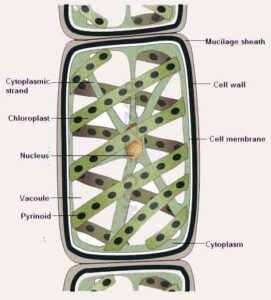
Vegetative structure of Spirogyra
They also contain other cellular organelles such as endoplasmic reticulum, Golgi bodies (dictyosomes), mitochondria, ribosomes, etc. which remains scattered within the cytoplasm.
Reproduction of Spirogyra
They increase in length of the filament takes place by ordinary cell divisions and by subsequent growth of individual cells, each of which may divide further. Spirogyra reproduces vegetatively and sexually. In this case, asexual reproduction is absent.
Vegetative Reproduction of Spirogyra
Vegetative reproduction in Spirogyra takes place by means of fragmentation. This is performed by softening of the cross wall between the two adjacent cells, as a result of which each part or piece of the broken filament grows out into a filament by repeated cell divisions, or by the accidental breaking of the filament by external mechanical injury.
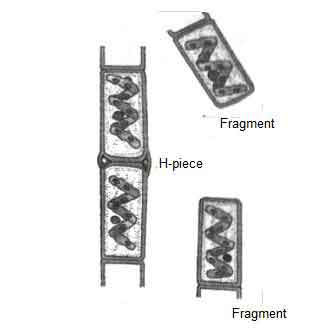
Sexual Reproduction of Spirogyra
Spirogyra may be monoecious or dioecious. Sexual reproduction takes place by conjugation of two morphologically identical gametes and each of which is called a gametangium. The sexual reproduction shows physiological anisogamy, as out of the two isogametes, one is motile, and the other one is non-motile. Sexual reproduction occurs at different times of the year according to species. Two types of conjugation are found in Spirogyra, which is described below:
Scalariform or Ladder Like Conjugation of Spirogyra
This type of conjugation takes place in the heterothallic species. In such cases, two filaments of opposite strains, i.e., + and – approach each other and lie in close association throughout their entire length. Now, the cells of the two associated filaments send out protuberances from the walls of the cells in opposite directions. These protuberances in due course come in contact with each other. Finally, the end walls of these protuberances are dissolved, forming a continuous passage, i.e., the conjugation tube.
The protoplasts of the conjugating cells begin to shrink to form gametes. The gamete of the cells of one filament shows amoeboid movement and move across the conjugation tube to the cells of the other filament. Now, the two gametes undergo fusion to form a dark-colored diploid zygospore body. The cell of the two filaments, along with the conjugation tube, gives a ladder-like appearance; hence, this type of conjugation is termed as scalariform or ladder-like conjugation.
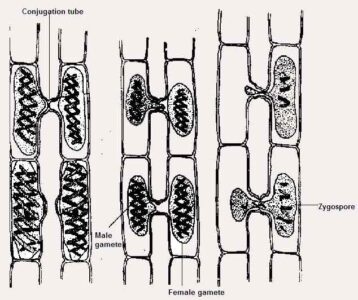
Lateral or Chain Like Conjugation of Spirogyra
This type of conjugation takes place between the adjacent cells of the same filament, i.e., in the homothallic species. Lateral walls of the conjugating cells of the same filament develop protuberances on either side of the cross wall. As the protuberance increases, the cross wall fails to maintain its connection with the lateral wall, whereby a passage is established between the two cells. Through this side passage, the shrunk protoplasts, i.e., the gamete (aplanogamete) of one cell, migrates into the adjacent cell and fuses with the other gamete. Fusion results in the formation of a diploid zygospore. This type of conjugation is termed as the lateral conjugation.

Germination of Gamete
The zygospore surrounds itself with a three-layered thick wall and is resistant to cold and drought. The zygospore generally sinks to the bottom of the water and after remaining dormant for some time, undergoes germination. The diploid nucleus undergoes meiosis forming four haploid nuclei, three of which degenerate, and one remains functional.
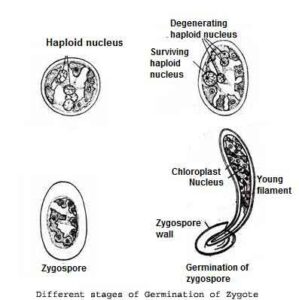
The wall ruptures, and the innermost cellulose layer emerges out in the form of a cylindrical germ tube. The germ tube undergoes transverse division to form 2 celled spirogyral filaments, which by repeated division gives rise to the cylindrical multi-cellular spirogyral filament. The functional haploid nucleus constitutes the nucleus of the haploid zygospore.
Parthenogenesis
Parthenogenesis may occur in Spirogyra by the development of perthenospore or azygospore. These are formed at the condition when the gametes fail to fuse. The gametes secrete a thick wall around it to become a perthenospore, which after a period of rest, germinate to form a new filament.
Life Cycle of Spirogyra
In the life cycle of Spirogyra, alternation of haploid (n) generation and diploid (2n) generation is noted. The haploid (n) phase is long, but the diploid (2n) phase is very short-lived. The diploid phase is restricted within the zygospore only.
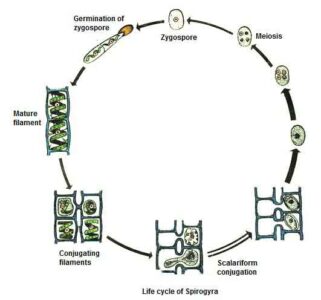
Concluding Remarks
The Spirogyra produces food matters by means of photosynthesis, and many aquatic animals use them as food. Spirogyra is used as fish`s food. Dried Spirogyra used in the preparation of soups. Spirogyra contains lots of vitamins A and E. It is cultured in garden tanks for ornamental purposes. Spirogyra is also used in the aquarium. Besides these, Spirogyra spoils the water of drinking tanks. If it grows in abundance, Spirogyra, create disturbances in swimming and fishing.

